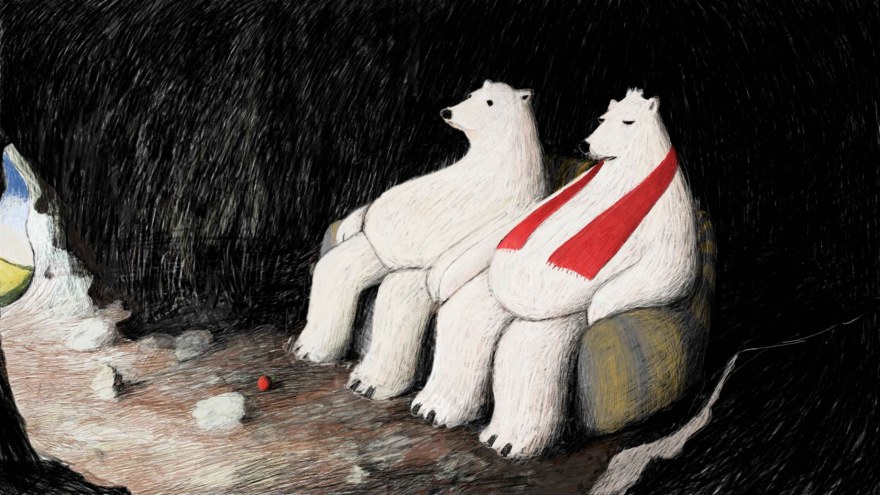Tea time with Apfelmus
Interview with Alexander Gratzer, director of Apfelmus
Apfelmus is a great animation short. How did you go about creating this philosophical tale?
At the time when I started working on the first scene of Apfelmus, I had no clear idea of what concrete action the film would take or how it would end. I deliberately refrained from making preliminary narrative decisions in order not to limit the improvisation at an early stage. Instead of creating a storyboard, I only established a formal framework, including the total duration of about seven minutes and three scenes of the same length in color, in order to be able to move around freely without losing the overview. Just like the storyline, the dialogue and the animation emerged step by step and in parallel. Small ideas followed one another chronologically from the first sentence of the birds to the last sentence of the polar bears. I kept going around in circles in my room, taking a good afternoon nap and drinking espresso with the hope of sparking ideas. When I finally came up with a good sentence, I recorded it, transferred it to my drawing program and made the lip – synch to it. Then I started to go around in circles again and thought about the appropriate reaction to the previous sentence. This type of improvisation has a big advantage for me: instead of working through the previously planned scenes, there is a lot of space for surprising moments, turns and ideas.
Can you shed light on what the guards symbolize or embody in your film?
Since Apfelmus was my diploma work for the study of painting at the University of Applied Arts in Vienna, I wanted to make a film about my experience there. It is because of this that the characters and dialogues are largely inspired by my environment at the university. For example, I had a teacher who preferred to wear a red scarf (to exude artistic seriousness) and spoke so “intellectually” that no one (not even himself) could understand him. As a young student, I was impressed by this intelligent-seeming talk and preferred to wear a red scarf for a while. But soon I longed for more humor in life and was tired of just playing a role. I often questioned the authenticity of my situation and wondered what it would be like in another, more “down to earth” life. Nevertheless, it took me some time to take the step out as some mental obstacle was in my way. So the two guards kind of symbolize this strange hurdle between the humorous life I wanted and my old “scarf-wearing” me.
Can you tell us a bit about your minimalist animation style?
When I look back at the first years of my life, it is funny to see that my love of minimalism has obviously hardly changed to this day. Even back then I preferred to draw only a very small detail, for example a tiny ear, on a large sheet of paper. Only recently I have started to worry more about composition and paper waste. Generally, I can say that I have a preference for such minimalism, which focuses all attention on the human and the peculiarities of the everyday life.
Would you say that the short film format has given you any particular freedom?
The longest film I made so far is Apfelmus (7′), so I can say little about the freedom of using longer formats. But I see a peculiarity in my filmmaking in that I have made my films alone with a few exceptions. That always gave me a pleasant freedom of choice. For example, I was able to decide day by day whether I would rather drink a fine cup of coffee or take an afternoon nap right away. Most of the time I decided to take the nap.
What do you consider your cinematographic references?
When I was a young boy I loved Monty Python. Once I galloped up and down in front of the class with two clattering coconuts to give a talk about Monty Python and the Holy Grail. Today my interest has expanded a bit, but what remains is the preference for filmmakers who deal with the seriousness of life with a good portion of humor. For example, the Swedish filmmaker Roy Andersson, who gives affectionate insights into Swedish life and the abysses of people with his bizarre stylized observations. Other filmmakers I really appreciate are: Jim Jarmusch (especially Coffee and Cigarettes, Night on Earth), Maren Ade (Toni Erdmann), Fatih Akin (especially In July, Head-on). Beside film artists I am a big fan of fine artists such as Pieter Bruegel the Elder or Grayson Perry. All of these artists have something in common: a loving view of human behavior and relations.
Apfelmus is part of International Competition I10.








